Project Overview
RANCHO CALIFORNIA ROAD ROUNDABOUT CORRIDOR
The Temecula Valley Wine Country Community Plan, adopted in 2014 by the Riverside County Board of Supervisors, envisioned the implementation of roundabouts at five intersections along Rancho California Road. The proposed four-mile roundabout corridor is located between Butterfield Stage Road and Glenoaks Road, with roundabouts planned at the intersections of La Serena Way, Calle Contento, Anza Road, Monte De Oro Road, and Glenoaks Road.
The use of roundabouts, instead of urbanized traffic signals, is intended to retain the unique rural character of the wine country region, where residents, equestrians, and visitors to the many wineries travel along Rancho California Road. The roundabouts will accommodate future traffic volumes, provide traffic calming, and increase public safety.
The roundabout at Anza Road was the first to be constructed and was opened for public use in 2012.
ANZA ROAD ROUNDABOUT (constructed in 2012)
The Transportation Department has completed the conceptual design for the four remaining roundabouts. The final design of the roundabouts at Calle Contento and La Serena Way is currently in progress. With a funding commitment from the Western Riverside Council of Governments (WRCOG), through the Transportation Uniform Mitigation Fee (TUMF) program, construction of the Calle Contento roundabout is expected to begin in 2027. The remaining roundabouts at La Serena Way, Monte De Oro Road, and Glenoaks Road will move forward as traffic needs are identified and as funding becomes available.
CALLE CONTENTO ROUNDABOUT (conceptual rendering)
The benefits of roundabouts are numerous, with safety being number one.
Safety. The Federal Highway Administration (FHWA) has reported that accidents are reduced at roundabouts compared with stop-controlled and signalized intersections. The most comprehensive study showed overall reductions of 35 percent in total collisions, 76 percent in injury collisions, and more than 90 percent in fatal collisions. The increased safety is achieved through the inherent design of the modern-day roundabout with one-directional flow around a central island and curves that slow vehicle speeds to 25 to 30 mph. The one-directional flow eliminates head-on collisions, and the slow speeds significantly reduce the severity of accidents and potential injuries.
Improved traffic flow. The FHWA reports that roundabouts have the benefit of lower overall delay in travel time for motorists compared to signalized and all-way stop-controlled intersections. Improved traffic flow is achieved by not requiring vehicles to stop. Instead, motorists slow down and yield to vehicles already within the circular roadway.
Reduced fuel usage and improved air quality. The reduced amount of stopped idling reduces fuel-consumption and vehicle emissions. This meets local, state, and federal goals of improving air quality and lessening the effects of greenhouse gases that cause global warming.
Tentative Project Schedule
Environmental Document Approval: Fall 2025
Final Design: Early 2026
Right of Way: Mid 2026
Construction Start: End 2027
Construction End: Mid 2028



